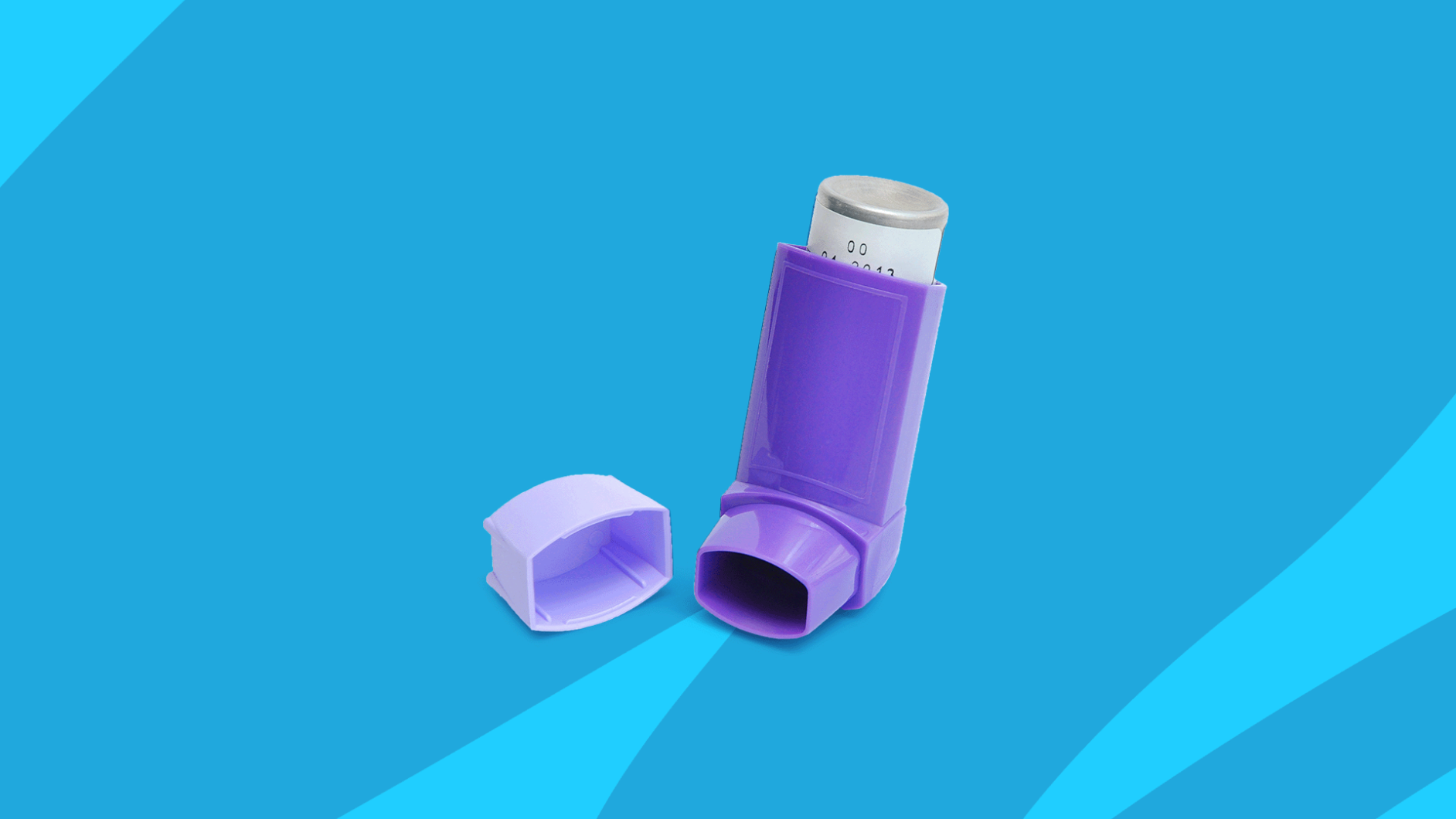Compare Pulmicort Flexhaler alternatives | Flovent Diskus/HFA | Qvar RediHaler | Advair Diskus/HFA | Breo Ellipta | Trelegy Ellipta | Natural alternatives | How to switch meds
Pulmicort Flexhaler is an inhaled prescription drug that contains the active ingredient budesonide. Pulmicort Flexhaler is part of a drug class called inhaled corticosteroids (ICS). Inhaled corticosteroids, also known as steroids, are considered the most effective type of medication used to control asthma symptoms. The way inhaled corticosteroids work on asthma is not fully understood. Medications like Pulmicort Flexhaler are thought to work by an anti-inflammatory action on various cells that are involved in causing inflammation and asthma symptoms.
Pulmicort Flexhaler is approved by the U.S. Food and Drug Administration (FDA) for the maintenance treatment of asthma—to prevent and control asthma symptoms like shortness of breath, chest tightness, and wheezing—in adults and children 6 years and older.
Pulmicort Flexhaler is a dry powder inhaler. A dry powder inhaler works by delivering medication into the lungs as you inhale through the device. It is available as a brand-name drug, and there is no generic available at this time. Pulmicort Flexhaler is made by the pharmaceutical company AstraZeneca Pharmaceuticals.
Sometimes, an individual may seek an alternative treatment to Pulmicort Flexhaler. Some people may not see the desired results and may want to try a different medication to see if it is more effective. Others may experience adverse effects that are bothersome or do not go away. Common side effects of Pulmicort Flexhaler include:
- Common cold
- Stuffy nose
- Sore throat
- Allergy symptoms such as sneezing
- Viral upper respiratory tract infection
- Nausea, vomiting, diarrhea
- Ear infection
- Yeast infection of the mouth
Some people cannot use dry powder inhalers because they contain lactose. People with severe milk protein allergies should not use Pulmicort Flexhaler or other dry powder inhalers because of the lactose content. Instead, they will be prescribed a metered-dose inhaler, which does not contain lactose. A metered-dose inhaler contains medicine that is delivered in the form of sprays, or mist, that is breathed into the lungs.
In rare cases, a serious side effect could occur, such as a severe allergic reaction. A severe allergic reaction can be life-threatening and can cause death. Symptoms of a severe allergic reaction require emergency medical attention. Symptoms may include hives, trouble breathing, and swelling of the face, lips, tongue, or throat.
In other cases, Pulmicort Flexhaler may be very expensive on your insurance plan, or it may require prior authorization.
If you are interested in exploring other options than Pulmicort Flexhaler, there are other medications that you can discuss with your healthcare provider.
What can I take in place of Pulmicort Flexhaler?
There are other types of asthma medications that can control asthma symptoms when Pulmicort Flexhaler cannot be taken or tolerated.
The table below compares Pulmicort Flexhaler with common alternatives. All drugs listed in the table are prescription medications approved by the United States Food and Drug Administration (FDA).
Note that Pulmicort Flexhaler and its alternatives are used to prevent and control symptoms. They are not used for immediate relief of symptoms. For immediate relief of asthma exacerbations, you would use your rescue inhaler, which is a form of albuterol or levalbuterol, such as ProAir HFA, Proventil HFA, Ventolin HFA, or Xopenex HFA.
Compare Pulmicort Flexhaler alternatives |
|||
|---|---|---|---|
| Drug name | Uses | Dosage | Savings options |
| Pulmicort Flexhaler (budesonide) |
Maintenance treatment of asthma (adults and children 6 years and older) | Inhale 2 puffs twice daily | Pulmicort Flexhaler coupons |
| Advair Diskus (fluticasone and salmeterol) |
Maintenance treatment of asthma (adults and children 4 years and older)
Maintenance treatment of COPD in adults |
Adults: Inhale 1 puff every 12 hours
Children: Varies by age |
Advair Diskus coupons |
| Alvesco (ciclesonide) |
Maintenance treatment of asthma (adults and adolescents 12 years and older) | Varies: a common dose is 1 puff twice daily | Alvesco coupons |
| Arnuity Ellipta (fluticasone furoate) |
Maintenance treatment of asthma (adults and children 5 years and older) | Adults: Inhale 1 puff once daily
Children: Varies |
Arnuity Ellipta coupons |
| Asmanex Twisthaler (mometasone) | Maintenance treatment of asthma (adults and children 4 years and older) | Varies: a common dose is 1 or 2 puff(s) daily | Asmanex coupons |
| Breo Ellipta (fluticasone furoate and vilanterol) |
Maintenance treatment of asthma in adults
Maintenance treatment of COPD in adults |
Inhale 1 puff daily | Breo Ellipta coupons |
| Dulera (mometasone and formoterol) |
Maintenance treatment of asthma (adults and children 5 years and older) | Inhale 2 puffs twice daily | More details |
| Flovent HFA (fluticasone propionate) |
Maintenance treatment of asthma (adults and children 4 years and older) | Adults: Inhale 2 to 4 puffs twice daily
Children: Varies |
Flovent HFA coupons |
| Qvar RediHaler (beclomethasone) |
Maintenance treatment of asthma (adults and children 4 years and older) | Adults: Inhale 1 to 4 puffs every 12 hours
Children: Varies |
Qvar RediHaler coupons |
| Symbicort (budesonide and formoterol) |
Maintenance treatment of asthma (adults and children 6 years and older)
Maintenance treatment of COPD in adults |
Adults: Inhale 2 puffs twice daily
Children: Varies |
Symbicort coupons |
| Trelegy Ellipta (fluticasone furoate, umeclidinium, and vilanterol) |
Maintenance treatment of asthma in adults
Maintenance treatment of COPD in adults |
Inhale 1 puff daily | Trelegy Ellipta coupons |
Other alternatives to Pulmicort Flexhaler
Inhaled medications:
- Advair HFA (fluticasone propionate and salmeterol)
- AirDuo Digihaler (fluticasone propionate and salmeterol)
- AirDuo Respiclick (fluticasone propionate and salmeterol)
- ArmonAir Digihaler (fluticasone propionate)
- Asmanex HFA (mometasone)
- Flovent Diskus (fluticasone propionate)
- Pulmicort Respules (budesonide): this is used in the nebulizer machine
- Spiriva Respimat (tiotropium)
- Wixela Inhub (fluticasone propionate and salmeterol)
Biologics:
- Cinqair (reslizumab) injection
- Dupixent (dupilumab) injection
- Fasenra (benralizumab) injection
- Nucala (mepolizumab) injection
- Xolair (omalizumab) injection
Oral medications:
- Accolate (zafirlukast)
- Singulair (montelukast)
- Theophylline
- Zyflo, Zyflo CR (zileuton)
Top 5 Pulmicort Flexhaler alternatives
The following drugs are some of the most common alternatives to Pulmicort Flexhaler.
1. Flovent Diskus/HFA
Flovent contains the ingredient fluticasone propionate, which is also an inhaled corticosteroid, like Pulmicort. Flovent Diskus contains fluticasone in a dry powder inhaler (which should not be used in people with a severe milk protein allergy). Flovent HFA is a metered-dose inhaler. Flovent Diskus or HFA can be used for the maintenance treatment of asthma in adults and children 4 years and older. Common side effects are similar to Pulmicort Flexhler and include upper respiratory infection symptoms, sore throat, headache, hoarseness, cough, nausea, vomiting, muscle and joint pain, rash, itching, and fungal infection of the mouth/throat.
2. Qvar RediHaler
Qvar Redihaler contains the ingredient beclomethasone, which is another inhaled corticosteroid. This medication is a metered-dose inhaler and can be used for the maintenance treatment of asthma in adults and children 4 years and older. Common side effects are similar to Pulmicort Flexhaler and Flovent. They include headache, sore throat, upper respiratory infection, stuffy nose, sinus infection, pain/back pain, nausea, cough, and fungal infection of the mouth.
3. Advair Diskus/HFA
Like Pulmicort Flexhaler, Advair contains an inhaled corticosteroid. Advair, though, is a combination drug. It contains the steroid fluticasone propionate. It also contains a drug called salmeterol, which is a long-acting beta-agonist. Long-acting beta-agonists (LABAs), also known as long-acting bronchodilators, help relax the airways and keep them open. LABAs by themselves are associated with an increase in asthma-related death—therefore, a LABA should always be used with an inhaled corticosteroid. This can be done by using a combination inhaler, such as Advair, or by using two different products. Many healthcare professionals choose to prescribe a combination inhaler rather than two separate inhalers, to ensure that both drugs are taken.
Advair Diskus is available as a dry powder inhaler, so those with a severe milk protein allergy should not use this medication. Advair Diskus can be used for the maintenance treatment of asthma in adults and children 4 years and older, as well as for the maintenance treatment of chronic obstructive pulmonary disease (COPD). Advair HFA is a metered-dose inhaler that can be used for the maintenance treatment of asthma in adults and children 12 years and older.
Common side effects of Advair include upper respiratory infection, headache, sore throat, cough, nausea, vomiting, diarrhea, indigestion, bronchitis, hoarseness, dizziness, palpitations, tremor, changes in taste, and fungal infection of the mouth.
4. Breo Ellipta
Like Advair, Breo Ellipta contains an inhaled corticosteroid (fluticasone furoate) and a LABA (vilanterol). It can be used for the maintenance treatment of asthma in adults as well as for the maintenance treatment of COPD in adults. Common side effects include common cold, headache, upper respiratory infection, back pain, sinus infection, fungal infection of the mouth, cough, joint pain, high blood pressure, sore throat, diarrhea, fever, fractures, and swelling of the extremities.
5. Trelegy Ellipta
Trelegy Ellipta contains three medications in one inhaler—an inhaled corticosteroid (fluticasone furoate), a LABA (vilanterol), and an anticholinergic (umeclidinium). Inhaled anticholinergic medications help to open up the airways. Trelegy Ellipta is indicated for the maintenance treatment of asthma and COPD in adults. Common side effects include upper respiratory infection symptoms, headache, back pain, altered taste, diarrhea, urinary tract infection, and fungal infection of the mouth.
Natural alternatives to Pulmicort Flexhaler
The American Lung Association recommends that people with asthma avoid triggers that can worsen asthma symptoms. Some common triggers include:
- Air pollution
- Animal dander
- Dust mites
- Exercise
- Food allergies such as nuts and shellfish
- Humidity as well as sudden or extreme temperature changes
- Medications such as aspirin or other nonsteroidal anti-inflammatory drugs (NSAIDs)
- Mold
- Respiratory infections such as colds, flu, or sinus infections
- Smoke (from cigarettes, or even fireplaces or burning leaves)
- Stress
- Strong odors such as from perfumes and cleaning supplies
- Trees, grass, pollen
There is no cure for asthma, so patients should avoid any supplements that claim to cure asthma. Certain natural therapies can help reduce asthma symptoms, such as using breathing techniques like pursed lip breathing or belly breathing; yoga; or exercise (as approved by your doctor). These should be used as a complement to the action plan from your doctor—not in place of prescription medication. You can discuss various asthma treatments with your healthcare provider.
How to switch to a Pulmicort Flexhaler alternative
If you are interested in switching to a Pulmicort Flexhaler alternative:
- Do not suddenly stop taking Pulmicort Flexhaler. This could worsen your symptoms.
- Consult your healthcare provider. Your healthcare provider is the only person who can decide which medications are appropriate for you.
- Before switching to another drug, review your medical history with your healthcare provider. Tell them about any allergies to medications, and tell them about all the medications you take, including prescription and over-the-counter drugs, vitamins, and supplements.
- Review instructions with your pharmacist on how to use the new inhaler. Be sure you understand how to use the inhaler as well as prime and clean it. After using an inhaler that contains a corticosteroid, whether it is Pulmicort or an alternative, rinse the mouth with water, then spit without swallowing. This helps prevent fungal infections of the mouth.
- Remember that Pulmicort Flexhaler (and its alternatives) are not rescue inhalers. They help to prevent and control symptoms. For asthma attacks with sudden symptoms like wheezing or shortness of breath, you will use your rescue inhaler.
- Search the SingleCare.com or mobile app for free coupons that can be used on prescriptions and refills. SingleCare customers can save up to 80% on prescription prices. Ask the pharmacist to compare your price with insurance vs. SingleCare.











